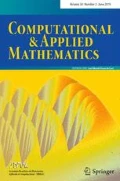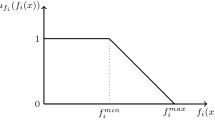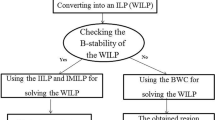Abstract
In the real world, some problems can be modelled by linear fractional programming with uncertain data as an interval. Therefore, some methods have been proposed for solving interval linear fractional programming (ILFP) problems. In this research, we propose two new methods for solving ILFP problems. In each method, we use two sub-models to obtain the range of the objective function. In the first method, we introduce two sub-models in which the objective functions are non-linear and the two sub-models have the largest and smallest feasible regions; therefore, the optimal value range of the objective function has been obtained. In the second method, two sub-models have been proposed in which the objective functions are linear and the optimal value of the objective function lies in the range obtained from the first method. We use our approaches to maximize the ratio of the facilities optimal allocation to the non-return fund in a bank.

Similar content being viewed by others
References
Alefeld G, Herzberger J (1983) Introduction to interval computations. Academic Press, New York
Allahdadi M, Mishmast Nehi H (2013) The optimal solution set of the interval linear programming problem. Optim Lett 7:1893–1911
Allahdadi M, Mishmast Nehi H (2017) Solving the interval linear programming problems by a new approach. ICIC Express Lett 11:17–25
Allahdadi M, Mishmast Nehi H, Ashayerinasab HA, Javanmard M (2016) Improving the modified interval linear programming method by new techniques. Inf Sci 339:224–236
Ashayerinasab HA, Mishmast Nehi H, Allahdadi M (2018) Solving the interval linear programming problem: a new algorithm for a general case. Expert Syst Appl 93:39–49
Bhurjee AK, Panda G (2012) Efficient solution of interval optimization problem. Math Methods Oper Res 76:273–288
Bhurjee AK, Panda G (2015) Multi-objective interval fractional programming problems: an approach for obtaining efficient solutions. Oper Res Soc India 52:156–167
Borza M, As Rambely, Saraj M (2012) Solving linear fractional programming problems with interval coefficients in the objective function, a new approach. Appl Math Sci 6:3443–3452
Charnes A, Cooper WW (1962) Programming with linear fractional functionals. Nav Res Logist Q 9:181–186
Chen L, Wu R, He Y, Yin L (2015) Robust stability and stabilization of fractional order linear systems with polytopic uncertainties. Appl Math Comput 257:274–284
Fiedler M, Nedoma J, Ramik J, Rohn J, Zimmermann K (2006) Linear optimization problems with inexact data. Springer, New York, pp 35–100
Ghadle KP, Pawar TS (2015) An alternative method for solving linear fractional programming problems. Int J Recent Sci Res 6:4418–4420
Gilmore PG, Gomory RE (1963) A linear programming approach to the cutting stock problem, part II. Oper Res 11:863–888
Hladik M (2010) Generalized linear fractional programming under interval uncertainty. Eur J Oper Res 205:42–46
Hoa NV (2018) Existence results for extremal solutions of interval fractional functional integro-differential equations. Fuzzy Sets Syst 347:29–53
Isbell JR, Marlow WH (1956) Attrition games. Nav Res Logist Q 3:71–94
Jeyakumar V, Li G, Srisatkunarajah S (2013) Strong duality for robust minimax fractional programming problems. Eur J Oper Res 228:331–336
Jiao H, Liu S (2014) A new linearization technique for minimax linear fractional programming. Int J Comput Math 91:1730–1743
Mesquine F, Hmamed A, Benhayoun M, Benzaoui A, Tadeo F (2015) Robust stabilization of constrained uncertain continuous-time fractional positive systems. J Frankl Inst 352:259–270
Mostafaee A, Hladik M (2016) Optimal value bounds in interval fractional linear programming and revenue efficiency measuring. Cent Eur J Oper Res. https://doi.org/10.1007/s10100-019-00611-6
Odior AO (2012) An approach for solving linear fractional programming problems. Int J Eng Technol 1:298–304
Radhakrishnan B, Anukokila P (2014) Fractional goal programming for fuzzy solid transportation problem with interval cost. Fuzzy Inf Eng 6:359–377
Soradi Zeid S, Effati S, Vahidian Kamyad A (2017) Approximation methods for solving fractional optimal control problems. Comp Appl Math. https://doi.org/10.1007/s40314-017-0424-2
Sun XK, Chai Y (2014) On robust duality for fractional programming with uncertainty data. Positivity 18:9–28
Tong SC (1994) Interval number, fuzzy number linear programming. Fuzzy Sets Syst 66:301–306
Veeramani C, Sumathi M (2016) Solving linear fractional programming problem under fuzzy environment: numerical approach. Appl Math Model 40:6148–6164
Wen CF (2012) An interval-type algorithm for continuous-time linear fractional programming problems. Taiwan J Math 16:1423–1452
Wen CF (2013) Continuous-time generalized fractional programming problems, part II: an interval-type computational procedure. J Optim Theory Appl 156:819–843
Zieniuk E, Kapturczak M, Kuzelewski A (2016) Solving interval systems of equations obtained during the numerical solution of boundary value problems. Comp Appl Math 35:629–638
Author information
Authors and Affiliations
Corresponding author
Additional information
Communicated by Anibal Tavares de Azevedo.
Publisher's Note
Springer Nature remains neutral with regard to jurisdictional claims in published maps and institutional affiliations.
Rights and permissions
About this article
Cite this article
Salary Pour Sharif Abad, F., Allahdadi, M. & Mishmast Nehi, H. Interval linear fractional programming: optimal value range of the objective function. Comp. Appl. Math. 39, 261 (2020). https://doi.org/10.1007/s40314-020-01308-2
Received:
Revised:
Accepted:
Published:
DOI: https://doi.org/10.1007/s40314-020-01308-2




